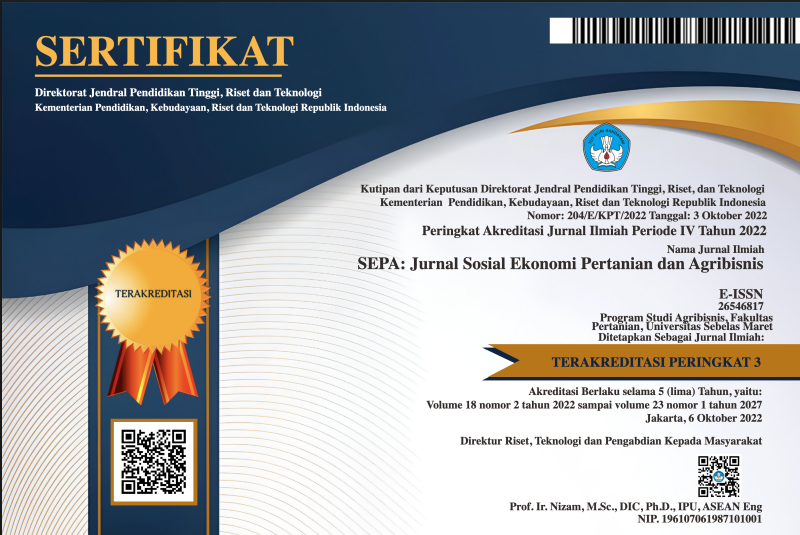DAYA SAING EKSPOR CENGKEH INDONESIA DI PASAR GLOBAL
Abstract
Increasing clove export market share in global markets has promising potential. The aims of this study are to identify the market structure of clove exporting countries and to measure the level of competitiveness and competitive advantage possessed by each exporting country. This study used time series data of Indonesian, Madagascar, Singapore and Comoro clove exports since 2001-2019. The CR4 method is used to identify the market structure, Revealed Comparative Advantage (RCA) used to measure the level of export competitiveness comparatively and Export Competitiveness Index (ECI) used to identify the competitive advantage of each exporting country. The results of the study stated that the market structure formed leads to an oligopoly market with Indonesia and Madagascar as market leaders. Meanwhile, the level of export competitiveness and competitive advantage possessed by Indonesia tend to increase. To increase the share of Indonesian clove exports can be done by conducting dissemination to clove farmers about cultivation technology. So, the farmers can produce high quality clove.
Keywords
Full Text:
PDFReferences
Ariesha, Y., Alamsyah, Z. and Malik, A., 2019. Analisis Komparasi Daya Saing Ekspor Lada Indonesia Terhadap Vietnam dan Malaysia di Pasar ASEAN. Jurnal Ilmiah Sosio-Ekonomika Bisnis, 22(1), pp.80–90.
Bano, S. and Scrimgeour, F., 2012. The Export Growth and Revealed Comparative Advantage of the New Zealand Kiwifruit Industry. International Business Research, 5(2), pp.73–82.
Bojnec, S. and Ferto, I., 2014. Export Competitiveness of Dairy Products on Global Markets: The Case of the European Union Countries. Journal of Dairy Science, 97(10), pp.6151–6163.
Direktorat Jenderal Perkebunan, 2020. Statistik Perkebunan Indonesia (Cengkeh).
FAOSTAT, 2020. Crops Statistics. [online] Food and Agriculture Organization of the United Nations. Available at: .
Frija, A., Dhehibi, B., Salah, M. Ben and Aw-Hassan, A., 2017. Competitive Advantage of GCC Date Palm Sector in the International Market: Market Shares, Revealed Comparative Advantages, and Trade Balance Indexes. International Journal of Marketing Studies, 9(6), p.1.
Granabetter, D., 2016. Revealed Comparative Advantage Index: an Analysis of Export Trade in the Austrian District of Burgenland. Review of Innovation and Competitiveness, 2(2), pp.97–114.
Hanafi, R.U. and Tinaprilla, N., 2019. Daya Saing Komoditas Kakao Indonesia Di Perdagangan Internasional. Psikologi Perkembangan, (October 2013), pp.1–224.
Kuldilok, K.S., Dawson, P.J. and Lingard, J., 2013. The Export Competitiveness of the Tuna Industry in Thailand. British Food Journal, 115(3), pp.328–341.
Lindung, L. and Jamil, A.S., 2018. POSISI DAYA SAING DAN TINGKAT KONSENTRASI PASAR EKSPOR KARET ALAM INDONESIA DI PASAR GLOBAL. Jurnal AGRISEP : Kajian Masalah Sosial Ekonomi Pertanian dan Agribisnis, 17(2), pp.119–128.
Narulita, S., Winandi, R. and Jahroh, S., 2014. Analisis Dayasaing Dan Strategi Pengembangan Agribisnis Kopi Indonesia. Jurnal Agribisnis Indonesia, 2(1), p.63.
Nikolić, A., Bajramović, S., Ognjenović, D., Lalić, D. and Uzunović, M., 2011. SEE Trade Liberalisation - New Opportunity for B&H Agrobusiness? British Food Journal, 113(1), pp.78–95.
Pratama, A.P. and Darwanto, D.H., 2019. The Competitiveness of Indonesian Cloves Commodity in International Market. IOP Conference Series: Earth and Environmental Science, 346(1), pp.0–9.
Saftiana, Y., 2014. Analisis Hubungan Rasio Konsentrasi , Intensitas Iklan, Dan Profitabilitas Industri Kosmetik Di Indonesia. Jurnal Manajemen Dan Bisnis Sriwijaya, 12(4), pp.243–258.
Sinta, N.M., Alamsyah, Z. and Elwamendri, 2017. Analisis Daya Saing Ekspor. Jurnal Ilmiah Sosio Ekonomika Bisnis, 20(1).
Trademap, 2020. Trade Statistics for International Business Development. [online] International Trade Centre. Available at: .
Zuhdi, F. and Suharno, S., 2016. Analisis Daya Saing Ekspor Kopi Indonesia dan Vietnam di Pasar ASEAN 5. Habitat Journal, 26, pp.152–162.
DOI: https://doi.org/10.20961/sepa.v17i2.43784
Refbacks
- There are currently no refbacks.



.png)







.png)
3.png)





